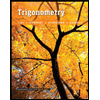In a polar coordinate system, we select a point, called the pole, and then a ray with vertex at the pole, called polar axis. A point P in a polar coordinate system is represented by an ordered pair of numbers (r,0). If r>0, then r is the distance of the point from the pole; 0 is an angle formed by the polar axis and a ray from the pole through the point. 0 = 2 3TT P= (r, €) • P= (2, ) 0 = 0 Or=1 r=3 r= 5 Polar axis O Pole 8 = 7T 3TT Polar grid 1. Use table of values and plotting points in polar grid to graph the polar equation 2 Compare your result with results of other members of your group. r = sin 0 2. What type of graph did you get?
In a polar coordinate system, we select a point, called the pole, and then a ray with vertex at the pole, called polar axis. A point P in a polar coordinate system is represented by an ordered pair of numbers (r,0). If r>0, then r is the distance of the point from the pole; 0 is an angle formed by the polar axis and a ray from the pole through the point. 0 = 2 3TT P= (r, €) • P= (2, ) 0 = 0 Or=1 r=3 r= 5 Polar axis O Pole 8 = 7T 3TT Polar grid 1. Use table of values and plotting points in polar grid to graph the polar equation 2 Compare your result with results of other members of your group. r = sin 0 2. What type of graph did you get?
Trigonometry (11th Edition)
11th Edition
ISBN:9780134217437
Author:Margaret L. Lial, John Hornsby, David I. Schneider, Callie Daniels
Publisher:Margaret L. Lial, John Hornsby, David I. Schneider, Callie Daniels
Chapter1: Trigonometric Functions
Section: Chapter Questions
Problem 1RE:
1. Give the measures of the complement and the supplement of an angle measuring 35°.
Related questions
Question

Transcribed Image Text:In a polar coordinate system, we select a point, called the **pole**, and then a ray with a vertex at the pole, called the **polar axis**. A point \( P \) in a polar coordinate system is represented by an ordered pair of numbers \( (r, \theta) \). If \( r > 0 \), then \( r \) is the distance of the point from the pole; \( \theta \) is an angle formed by the polar axis and a ray from the pole through the point.
### Diagram Explanation
- **Left Diagram**: Shows the basic representation of a polar coordinate system. The point \( P = (r, \theta) \) is located using the distance \( r \) from the pole \( O \) and angle \( \theta \) from the polar axis.
- **Right Diagram**: Depicts a polar grid with points plotted.
- The grid includes several concentric circles with radii marked (e.g., \( r = 1, 3, 5 \)).
- Various angles \( \theta \) (e.g., \( \theta = 0, \frac{\pi}{4}, \frac{\pi}{2}, \pi \)) are indicated along the circular grid.
- Specific points like \( P = (2, \frac{\pi}{4}) \) and \( Q = (4, \frac{5\pi}{4}) \) are highlighted on the grid, showing their positions relative to the pole.
### Exercises
1. Use a table of values and plot points on the polar grid to graph the polar equation \( r = \frac{2}{\sin \theta} \). Compare your result with results of other members of your group.
2. What type of graph did you get?
Expert Solution
This question has been solved!
Explore an expertly crafted, step-by-step solution for a thorough understanding of key concepts.
This is a popular solution!
Trending now
This is a popular solution!
Step by step
Solved in 3 steps with 2 images

Recommended textbooks for you

Trigonometry (11th Edition)
Trigonometry
ISBN:
9780134217437
Author:
Margaret L. Lial, John Hornsby, David I. Schneider, Callie Daniels
Publisher:
PEARSON

Trigonometry (MindTap Course List)
Trigonometry
ISBN:
9781305652224
Author:
Charles P. McKeague, Mark D. Turner
Publisher:
Cengage Learning


Trigonometry (11th Edition)
Trigonometry
ISBN:
9780134217437
Author:
Margaret L. Lial, John Hornsby, David I. Schneider, Callie Daniels
Publisher:
PEARSON

Trigonometry (MindTap Course List)
Trigonometry
ISBN:
9781305652224
Author:
Charles P. McKeague, Mark D. Turner
Publisher:
Cengage Learning


Trigonometry (MindTap Course List)
Trigonometry
ISBN:
9781337278461
Author:
Ron Larson
Publisher:
Cengage Learning